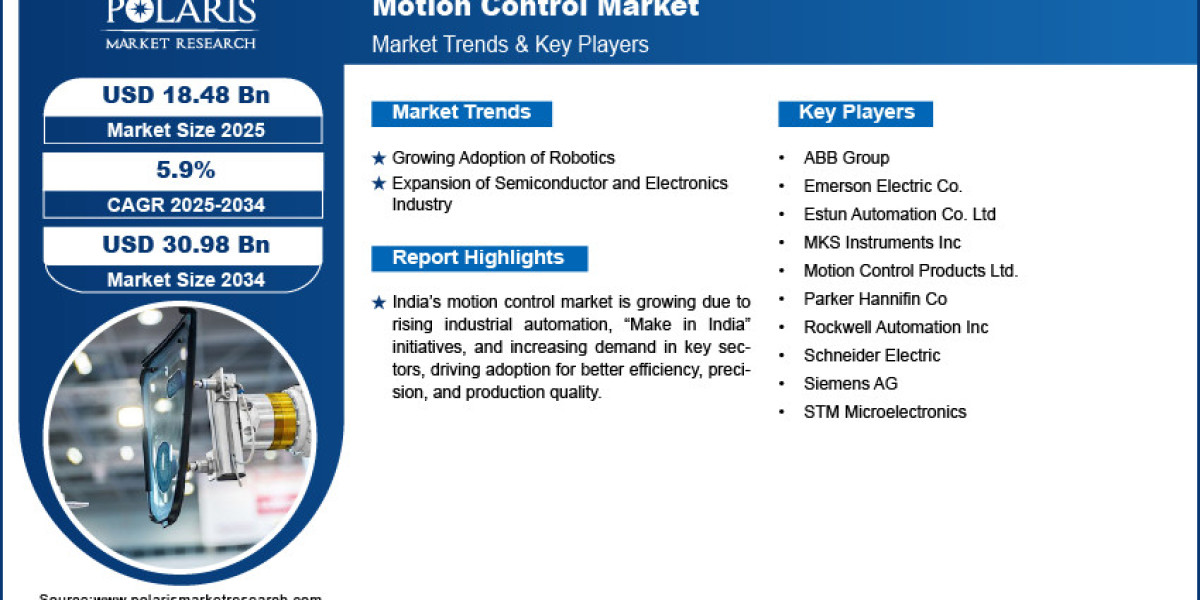The motion control market size was valued at USD 17.47 billion in 2024. It is projected to grow from USD 18.48 billion in 2025 to USD 30.98 billion by 2034, exhibiting a compound annual growth rate (CAGR) of 5.9% during 2025–2034.
Market Segmentation
The Motion Control Market is segmented based on component, system type, application, industry vertical, and region, highlighting the vast and dynamic nature of the industry.
1. By Component:
- Motors
- Servo Motors
- Stepper Motors
- Drives
- AC Drives
- DC Drives
- Controllers
- PLC Systems
- Motion Controllers
- Software & Services
Servo motors dominate this segment due to their widespread use in high-performance and precision-driven applications. The rise in demand for compact and energy-efficient motors across industrial robotics and CNC machinery has further propelled their adoption.
2. By System Type:
- Open Loop Systems
- Closed Loop Systems
Closed loop systems account for a larger market share due to their superior feedback mechanisms and accuracy in complex industrial processes. These systems are widely employed in applications requiring consistent precision and error correction.
3. By Application:
- Material Handling
- Packaging
- Robotics
- Conveying Systems
- Metal Cutting and Forming
- Semiconductor Machinery
The robotics application segment is projected to witness the fastest growth. Motion control systems serve as the backbone for robotic movement and operational synchronization, particularly in assembly lines and warehouse automation.
4. By Industry Vertical:
- Automotive
- Electronics & Semiconductor
- Aerospace & Defense
- Food & Beverage
- Healthcare & Pharmaceuticals
- Oil & Gas
- Industrial Manufacturing
The automotive industry leads in market share, driven by growing production automation and the implementation of robotic automation in manufacturing processes. The electronics & semiconductor sector is also rapidly adopting motion control systems to support miniaturization and precision manufacturing.
Regional Analysis
The motion control market shows significant regional variation, reflecting the industrial maturity, automation adoption, and economic landscape of each area.
1. North America
North America remains a key market, characterized by early adoption of PLC systems, robust investments in industrial robotics, and a strong presence of advanced manufacturing sectors. The U.S. leads the region, with high demand for motion control solutions in aerospace, defense, and automotive applications.
2. Europe
Europe is the second-largest market, driven by Germany, the UK, and Italy—countries with strong automotive and industrial machinery sectors. The region is investing heavily in energy-efficient and environmentally sustainable motion control technologies. Moreover, government support for smart manufacturing under initiatives like “Industry 4.0” has further accelerated market growth.
3. Asia-Pacific
The Asia-Pacific region is the fastest-growing market, propelled by rapid industrialization in China, Japan, South Korea, and India. China, in particular, is a major manufacturing hub and a leader in industrial automation adoption. The proliferation of industrial drives, motorized systems, and advanced robotic solutions is enhancing production efficiencies across multiple verticals.
4. Latin America and Middle East & Africa (MEA)
Latin America and MEA are emerging markets, gradually adopting automation technologies to address labor shortages and enhance operational productivity. Brazil and Mexico show promise in automotive and packaging, while the Middle East is investing in motion control for energy, oil & gas, and infrastructure development.
Read More @ https://www.polarismarketresearch.com/industry-analysis/motion-control-market
Key Companies
The competitive landscape of the motion control market features a combination of global giants and innovative mid-sized firms. These companies are continuously investing in R&D, strategic partnerships, and product enhancements to stay ahead in the evolving market.
1. Siemens AG
A global automation leader, Siemens offers a wide range of motion control systems, including servo motors, drives, and motion controllers. Its SIMOTION and SINAMICS platforms are widely deployed in smart factories and robotics applications worldwide.
2. Schneider Electric
Schneider Electric is known for its energy-efficient automation and control solutions. The company’s PLC systems and motion controllers are integrated into diverse industries such as water treatment, logistics, and food processing.
3. Rockwell Automation
Rockwell’s Allen-Bradley line of drives, motors, and controllers is a cornerstone in U.S. manufacturing plants. The company is focused on delivering integrated motion control systems with high-performance scalability and digital connectivity.
4. Mitsubishi Electric Corporation
Mitsubishi Electric provides cutting-edge motion control products, including servo motors, AC drives, and robotic controllers. Their offerings are particularly strong in robotic automation and electronics manufacturing.
5. ABB Ltd.
ABB is a key player with a strong portfolio in industrial robotics, motion control, and automation systems. Its motion control solutions are widely used in the automotive, packaging, and logistics sectors.
6. Yaskawa Electric Corporation
Yaskawa specializes in industrial drives and motion control systems for a wide range of applications. It is recognized for its contributions to high-speed automation and precision engineering.
7. Fanuc Corporation
Fanuc offers integrated CNC systems, drives, and motors used extensively in machine tools and robotics. The company has been a pivotal contributor to the expansion of motion control solutions in Asia.
8. Bosch Rexroth AG
Bosch Rexroth delivers advanced motion control technologies for manufacturing and process industries. The company emphasizes digital transformation, offering systems with high-level IoT and predictive maintenance capabilities.
Market Trends and Opportunities
Several trends are reshaping the motion control landscape, opening new growth opportunities for both manufacturers and integrators:
1. Rise of Robotic Automation
The demand for robotic automation in assembly, welding, and packaging is driving significant investment in motion control systems. Industrial and collaborative robots (cobots) require precise motion regulation for safe and accurate operations.
2. Integration of IoT and AI
Smart motion controllers integrated with sensors and AI algorithms are enabling real-time analytics, adaptive motion planning, and predictive maintenance. These advancements help reduce downtime and optimize energy consumption.
3. Growth in PLC Systems
Modern PLC systems are becoming smarter and more compact, supporting multitasking and flexible programming. They are pivotal in driving automation across medium and small enterprises.
4. Energy Efficiency and Sustainability
With increasing focus on environmental standards, motion control systems are being designed to minimize energy usage through regenerative braking, efficient drives, and smart load management.
5. Customization and Modular Design
The growing demand for modular and customizable systems is enabling manufacturers to offer flexible solutions tailored to specific industry needs, reducing costs and improving integration time.
Conclusion
The Global Motion Control Market stands at the forefront of the next wave of industrial transformation. From smart factories and high-speed packaging lines to autonomous robotics and semiconductor fabrication, motion control systems are enabling precision, speed, and efficiency like never before.
With servo motors, industrial drives, PLC systems, and robotic automation acting as cornerstones of modern manufacturing, companies across sectors are poised to embrace motion control solutions to gain a competitive edge in the evolving digital landscape.
As global industries align with automation trends and smart infrastructure, the motion control market will continue to be a vital enabler of innovation and productivity in the years ahead.
More Trending Latest Reports By Polaris Market Research:
Laparoscopic Retrieval Bag Market
Personal Protective Equipment (PPE) Market
Refurbished Medical Imaging Equipment Market
Corporate Lending Platform Market
Flow Computer in Oil & Gas Market
North America Skin Boosters Market
Mining Drills And Breakers Market








